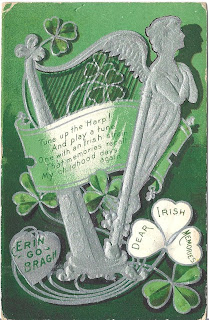A card celebrating to excess the "wearing of the green", mailed on March 17, 1911. It has a sufragette feel to it somehow, and I love that the woman has red hair.
There's a famous ballad, that appeals to the rebellious Irish in all of us:
"Oh Paddy dear, and did ye hear the news that's going round?
The shamrock is forbid by law to grow on Irish ground!
No more St. Patrick's Day we'll keep; his color can't be seen,
For there's a cruel law agin' the wearing o' the Green!"
Don't forget to wear green today, or you'll be sure to get pinched.
Happy St. Patrick's Day!
Showing posts with label St. Patrick's Day. Show all posts
Showing posts with label St. Patrick's Day. Show all posts
Wednesday, March 17, 2010
Tuesday, March 16, 2010
St. Patrick's Day Eve
No respectable St. Patrick's Day greeting is complete without some use of the shamrock. It's a registered trademark by the Government of Ireland, and is used in the names and logos of Irish pubs all over the world. Legend has it that the shamrock was used by St. Patrick to illustrate the Holy Trinity, but as no mention of this has ever been found in any of his writings, many question its authenticity.
Note: While neither of these cards is dated, I have to assume they're from the same years as all the other cards in this collection - around 1910 or 1911.
Monday, March 15, 2010
St. Patrick's Day II
Two more St. Patrick's Day cards, the one on the right from 1911, the one on the left undated.
Both show the Old Weir Bridge in Killarney, Ireland. Killarney, County Kerry, is one of the most well-loved tourist destinations in Ireland and there are boat rides available that pass under the Old Weir Bridge, except when the waters are low when you have to get out of the boat and walk around the bridge to the other side.
Check out the multiplicity of Irish icons on the card on the right: the pipe, the harp, and shamrock. A good site for information on these Irish symbols and more can be found here (you have to scroll down a bit to find the "Irish Symbols" listing). More information than you ever knew existed about the legend of the shamrock can be found here.
Friday, March 12, 2010
St. Patrick's Day
It's Postcard Friendship Friday, and the posting of postcards for St. Patrick's Day has begun, with the theme suggested by the event's new hostess.
Both of these cards were sent in 1911, and are part of my friend Debra's holiday postcard collection she got from her grandmother.
I had to look up the origins of St. Patrick's Day, and it turns out the Irish have been commemorating the day for over 1000 years.
This from History.com: "St. Patrick's Day is celebrated on March 17, his religious feast day and the anniversary of his death in the fifth century. The Irish have observed this day as a religious holiday for over a thousand years. On St. Patrick's Day, which falls during the Christian season of Lent, Irish families would traditionally attend church in the morning and celebrate in the afternoon. Lenten prohibitions against the consumption of meat were waived and people would dance, drink and feast—on the traditional meal of Irish bacon and cabbage."
And so it could be said that St. Patrick's Day started as a way to get out of the restrictions of Lent, at least for a day!
Also had to look up the significance of the harp, seen in both postcards.
From Wikipedia: "Until the end of the Middle Ages the Gaelic harp (the historical clarsach or Irish harp) was the highest status musical instrument of both Scotland and Ireland, and harpers were amongst the most prestigious cultural figures amongst Irish and Scottish kings and chiefs. In both countries, the harper enjoyed special rights and played a crucial part in ceremonial occasions such as coronation and poetic recital. The main function of the Gaelic harp in medieval Scotland and Ireland seems to have been playing to accompany the recitation of bardic poetry in Gaelic or Irish.
And from Symbols of Ireland: "The harp has long been a symbol of Ireland. Perhaps the legends of it's magical powers comes from the time when the bards would sing and tell stories of famous events to the Irish kings and chiefs. During the early 1500s, under the rule of Henry VIII, the harp was first depicted on Irish coins. That tradition is carried on today and the harp is also used for other official duties such as the Irish state seal, official documents and uniforms."
Finally, it's too bad metalic silver doesn't show well on-line, as both cards are actually metallic silver where they look grey.
Erin go bragh!
Subscribe to:
Posts (Atom)





.jpg)




